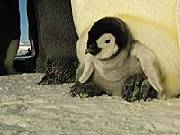|
|
||||
|
|
by Donald Levit  Hastened by a general shift itself immeasurably the byproduct of technological advances in cinema and television, a past innocence and capacity for wonder are dying if not gone. The Conquest of Everest, The Silent World, and Disney’s Seal Island and subsequent “True-Life Adventure” feature series would probably not stir the current rising generation. Proof of the pudding followed the screening of March of the Penguins/La Marche de l’empereur, when a twenty-something-year-old pronounced Luc Jacquet’s Warner-National Geographic documentary “not very interesting” and two youngsters disbelieved adult assurances that no footage, not even below ice-covered Antarctic waters (by Patrick Marchand and François de Riberolles), had been artificially generated. How, one asks, is sensibility to the marvels and horrors of “true-life” again to compete with the Virtual Reality of graphics, special effects and stuntwork? The film in question is not without flaws, and the unseen (except a few end-credit stills) exploits of the crew itself are perhaps the equal of the actual genetic survival story, but this is the sort of work that an older generation approves of and that parents will want their children to see and appreciate. As with the above-mentioned films, this is a case where an absorbing offshoot could have been made à la Hearts of Darkness: A Filmmaker’s Apocalypse or, more to the point, Burden of Dreams; though of course it would involve a whole ‘nother film -- super-16mm cameramen Jérôme Maison and Laurent Chalet (and their equipment) endured thirteen months, without any possibility of sea or air evacuation, the same whiteouts, hundred-fifty-mph katabatic winds and -70°F temperatures, though minus predatory leopard seals, orcas, giant petrels and skuas, as their flightless aquatic bird subjects, the stately emperor penguins (Aptenodytes forsteri). The public has grown so accustomed to shallow, wisecracking, movie star-voiced, cartoonishly anthropomorphized animal characters, that the stoical, monkish-looking birds seem deceptively calm, hence “unexciting.” So it needs to be told that “in some ways this is a story of survival, of life over death. But it’s more than that: it’s a story of love,” in Morgan Freeman’s one-note reading of Jordan Roberts’ scripted narration. However low-key, the voice is a distraction, a sad emphasis on human parallels and a lack of confidence that an audience can be trusted to pick up on elemental, nearly soundless drama the way it once did with Flaherty’s pre-soundtrack Nanook of the North. Alex Wurman’s not easily classifiable faintly jazz score provides the only accompaniment necessarily suitable for this stark tragedy-and-triumph saga of instinctual, cyclical renewal. With one single high-grain aurora australis, the backdrop is color-drained to a whitish-grey that shimmers blue, silhouetting the slow-stepping black pilgrim-cowled penguins with incongruous orange temple spots and pink underbeak slits. Conceived originally for television, the film had no script as such, for although what would happen was known beforehand, the how was incognito. But if the actual instinctive mechanisms remain to be discovered, this penguin colony has likely followed the same migratory mating and chick-rearing rituals since the tropical continent drifted as far south as it could go and donned its two-to-three-mile ice cap. After frolicking and fattening up at sea for the summer months of January to March, the colony begins a long trek inland as winter approaches. At the inhospitable breeding grounds, dignified courtship takes place, and for the cycle the paired birds stay monogamous and self-sacrificing unto death for the single egg which is laid, the survival of which is foreseeably precarious. The camera records the beautiful year’s length cycle, aided by the penguins’ Galapagos unfamiliarity with, and lack of fear of, man. In immemorial dance of life and hope, the protective stomach flap is raised and the egg transferred from atop the exhausted female’s feet to a similar spot on the male. Having each lost some twenty of her sixty pounds, the females start the dangerous, single-file, reverse walk to food in a sea now more distant due to new coastal ice, while, like seahorses, the males incubate the egg and fast for the four winter months until, after birth of the chicks, the mothers return. Transferring the chick in the manner of the egg, the male instructs his own with a song-note for future family recognition and, half his own body weight gone, sets off on the seaward journey that will be repeated several times by each parent, until the surviving fledglings are old and strong enough to be left to find their own mysterious way to the shore. Against this vast whiteness that strangely appears all horizontal with scant verticality, the elemental drama plays out annually. Amazing, but true. The story is quiet, but the process and mere fact of species survival is majestic, and so, again, the film would have benefited from less Homo sapiens voice and fewer humanizing judgements about “our tuxedoed friends”: the taciturn, stiff-feathered stars are perfectly capable of making it on their own. (Released by Warner Independent Pictures and National Geographic Feature Films; rated "G" as suitable for all ages.) |
||
|
© 2025 - ReelTalk Movie Reviews Website designed by Dot Pitch Studios, LLC |



